Conformational and Supramolecular Aspects in Chirality of Flexible Camphor-Containing Schiff Base as an Inducer of Helical Liquid Crystals
Abstract
:1. Introduction
2. Results and Discussion
3. Materials and Methods
3.1. Measurement of UV/Vis, CD Spectra
3.2. NMR Measurement
3.3. Optical Rotation and Dipole Moment
3.4. Quantum-Chemical Calculations
3.5. Measurement of Phase Transitions Temperatures
3.6. Measurement of Pitch
3.7. Measurement of Permittivity
3.8. Measurement of Refraction Indices
4. Conclusions
Supplementary Materials
Author Contributions
Funding
Data Availability Statement
Acknowledgments
Conflicts of Interest
References
- Al-Qadsy, I.; Saeed, W.S.; Al-Odayni, A.-B.; Ahmed Saleh Al-Faqeeh, L.; Alghamdi, A.A.; Farooqui, M. Novel Metformin-Based Schiff Bases: Synthesis, Characterization, and Antibacterial Evaluation. Materials 2020, 13, 514. [Google Scholar] [CrossRef] [PubMed] [Green Version]
- Slassi, S.; Fix-Tailler, A.; Larcher, G.; Amine, A.; El-Ghayoury, A. Imidazole and Azo- Based Schiff Bases Ligands as Highly Active Antifungal and Antioxidant Components. Heteroat. Chem. 2019, 2019, 6862170. [Google Scholar] [CrossRef]
- Shah, S.S.; Shah, D.; Khan, I.; Ahmad, S.; Ali, U.; ur Rahman, A. Synthesis and Antioxidant Activities of Schiff Bases and Their Complexes: An Updated Review. Biointerface Res. Appl. Chem. 2020, 10, 6936–6963. [Google Scholar] [CrossRef]
- Xavier, A.; Srividhya, N. Synthesis and study of Schiff base ligands. IOSR J. Appl. Chem. 2014, 7, 6–15. [Google Scholar] [CrossRef]
- Rao, C.; Gerard, V.; Dickmu, C.; Ugrinov, A.; Smoliakova, I.P. New optically active camphor-derived cyclopalladated complexes with an asymmetric carbon bonded to the metal. J. Organomet. Chem. 2019, 900, 120917. [Google Scholar] [CrossRef]
- Obali, A.Y.; Ucan, H.I. Novel dipodal Schiff base compounds: Synthesis, characterization and spectroscopic studies. J. Mol. Struct. 2015, 1081, 74–78. [Google Scholar] [CrossRef]
- Iwan, A.; Janeczek, H.; Jarzabek, B.; Rannou, P. Mesomorphic Behavior of Symmetrical and Unsymmetrical Azomethines with Two Imine Groups. Materials 2009, 2, 38–61. [Google Scholar] [CrossRef] [Green Version]
- Oreshko, V.V.; Kovaleva, K.S.; Mordvinova, E.D.; Yarovaya, O.I.; Gatilov, Y.V.; Shcherbakov, D.N.; Bormotov, N.I.; Serova, O.A.; Shishkina, L.N.; Salakhutdinov, N.F. Synthesis and Antiviral Properties of Camphor-Derived Iminothiazolidine-4-Ones and 2,3-Dihydrothiazoles. Molecules 2022, 27, 4761. [Google Scholar] [CrossRef] [PubMed]
- Groselj, U.; Sevšek, A.; Ričko, S.; Golobič, A.; Svete, J.; Stanovnik, B. Synthesis and Structural Characterization of Novel Camphor-derived Amines. Chirality 2012, 24, 778–788. [Google Scholar] [CrossRef] [PubMed]
- Boobalan, R.; Chen, C.; Lee, G.-H. Camphor-based Schiff base ligand SBAIB: An enantioselective catalyst for addition of phenylacetylene to aldehydes. Org. Biomol. Chem. 2012, 10, 1625–1638. [Google Scholar] [CrossRef] [PubMed]
- Blocka, E.; Bosiak, M.J.; Welniak, M.; Ludwiczak, A.; Wojtczak, A. Enantioselective cyanosilylation of aldehydes catalyzed by novelcamphor derived Schiff bases-titanium (IV) complexes. Tetrahedron Asymmetry 2014, 25, 554–562. [Google Scholar] [CrossRef]
- Zhao, G.; Yang, C.; Sun, H.; Lin, R.; Xia, W. (+)-Camphor Derivative Induced Asymmetric [2+2] Photoaddition Reaction. Org. Lett. 2012, 14, 776–779. [Google Scholar] [CrossRef]
- Liu, Q.-L.; Chen, W.; Jiang, Q.-Y.; Bai, X.-F.; Li, Z.; Xu, Z.; Xu, L.-W. A d-Camphor-Based Schiff Base as a Highly Efficient N,P Ligand for Enantioselective Palladium-Catalyzed Allylic Substitutions. ChemCatChem 2016, 8, 1495–1499. [Google Scholar] [CrossRef]
- Pollok, C.H.; Riesebeck, T.; Merten, C. Photoisomerisierung eines Schalters auf Basis eines chiralen Imins: Verfolgung durch Matrixisolations-VCD-Spektroskopie. Angew. Chem. 2017, 129, 1952–1955. [Google Scholar] [CrossRef]
- Kamoun, E.; Winkel, A.; Eisenburger, M.; Menzel, H. Carboxylated Camphorquinone as Visible-Light Photoinitiator for Biomedical Application: Synthesis, Characterization, and Application. Arab. J. Chem. 2016, 9, 745–754. [Google Scholar] [CrossRef] [Green Version]
- Greb, L.; Eichhofer, A.; Lehn, J.-M. Synthetic Molecular Motors: Thermal N Inversion and Directional Photoinduced CN Bond Rotation of Camphorquinone Imines. Angewandte Chem. 2015, 54, 4345–14348. [Google Scholar] [CrossRef]
- Sokolova, A.S.; Kovaleva, K.S.; Yarovaya, O.I.; Bormotov, N.I.; Shishkina, L.N.; Serova, O.A.; Sergeev, A.A.; Agafonov, A.P.; Maksuytov, R.A.; Salakhutdinov, N.F. (+)-Camphor and (−)-borneol derivatives as potential anti-orthopoxvirus agents. Arch. Pharm. 2021, 354, e2100038. [Google Scholar] [CrossRef] [PubMed]
- Sokolova, A.S.; Yarovaya, O.I.; Bormotov, N.I.; Shishkinac, L.N.; Salakhutdinov, N.F. Synthesis and antiviral activity of camphor-based 1,3-thiazolidin-4-one and thiazole derivatives as Orthopoxvirus-reproduction inhibitors. Med. Chem. Commun. 2018, 9, 1746–1753. [Google Scholar] [CrossRef] [PubMed]
- Wang, Y.; Busch-Petersen, J.; Wang, F.; Kiesow, T.J.; Graybill, T.L.; Jin, J.; Yang, Z.; Foley, J.J.; Hunsberger, G.E.; Schmidt, D.B.; et al. Camphor sulfonamide derivatives as novel, potent and selective CXCR3 antagonists. Bioorg. Med. Chem. Lett. 2009, 19, 114–118. [Google Scholar] [CrossRef]
- Cardoso, J.M.S.; Guerreiro, S.I.; Alves, M.M.; Montemor, M.F.; Mira, N.P.; Leitão, J.H.; Carvalho, M.F.N. Ag(I) camphorimine complexes with antimicrobial activity towards clinically important bacteria and species of the Candida genus. PLoS ONE 2017, 12, e0177355. [Google Scholar] [CrossRef] [Green Version]
- Carreno, A.; Zuniga, C.; Paez-Hernandez, D.; Gacitua, M.; Polanco, R.; Otero, C.; Arratia-Perez, R.; Fuentes, J.A. Study of the structure–bioactivity relationship of three new pyridine Schiff bases: Synthesis, spectral characterization, DFT calculations and biological assays. New J. Chem. 2018, 42, 8851. [Google Scholar] [CrossRef]
- Sokolova, A.S.; Yarovaya, O.I.; Baev, D.S.; Shernyukov, A.V.; Shtro, A.A.; Zarubaev, V.; Salakhutdinov, N.F. Aliphatic and alicyclic camphor imines as effective inhibitors of influenza virus H1N1. Eur. J. Med. Chem. 2017, 127, 661–670. [Google Scholar] [CrossRef] [PubMed]
- Artyushin, O.I.; Sharova, E.V.; Vinogradov, N.M.; Genkina, G.K.; Moiseeva, A.A.; Klemenkova, Z.S.; Orshanskaya, I.R.; Shtro, A.A.; Kadyrova, R.A.; Zarubaev, V.V.; et al. Synthesis of camphecene derivatives using click chemistry methodology and study of their antiviral activity. Bioorg. Med. Chem. Lett. 2017, 27, 2181–2184. [Google Scholar] [CrossRef]
- Sokolova, A.S.; Yarovaya, O.I.; Korchagina, D.V.; Zarubaev, V.V.; Tretiak, T.S.; Anfimov, P.M.; Kiselev, O.I.; Salakhutdinov, N.F. Camphor-based symmetric diimines as inhibitors of influenza virus reproduction. Bioorganic. Med. Chem. 2014, 22, 2141–2148. [Google Scholar] [CrossRef]
- Galvao, A.M.; Fernanda, M.; Carvalho, N.N.; Ferreira, A.S.D. Supramolecular arrangement in mono and bi-camphor acyl hydrazones: A structural study. J. Mol. Struct. 2016, 1108, 708–716. [Google Scholar] [CrossRef]
- Burmistrov, V.A.; Novikov, I.V.; Aleksandriiskii, V.V.; Islyaikin, M.K.; Koifman, O.I. Intermolecular interactions and chiral induction in nematic liquid crystal phase by camphorsubstituted 2,3-dicyanopyrazine. J. Mol. Liq. 2017, 244C, 398–404. [Google Scholar] [CrossRef]
- Filatov, M.S.; Trukhina, O.N.; Rodríguez-Morgadec, M.S.; Islyaikin, M.K.; Koifman, O.I.; Torres, T. Synthesis and spectroscopic properties of chiral bornane [2,3-b] pyrazino-fused [30] trithiadodecaazahexaphyrins. Porphyr. Phthalocyanines 2014, 18, 1014–1020. [Google Scholar] [CrossRef]
- Burmistrov, V.A.; Novikov, I.V.; Aleksandriiskii, V.V.; Islyaikin, M.K.; Kuznetsova, A.S.; Koifman, O.I. Appearance of induced chiral nematic phase in solutions of 4-n-alkyloxy-4 ‘- cyanobyphenyles with symmetric camphorsubstituted hemiporphyrazines. J. Mol. Liq. 2019, 287, 110961. [Google Scholar] [CrossRef]
- Niquini, F.M.; Machado, P.H.; Valadares Rodrigues, J.H.; Pontes-Silva, A.V.; Figueiredo, R.C.; Silveira, R.G.; Corrêa, R.S. On the experimental and theoretical calculations of rotameric conformations of a new Schiff base derived from amantadine. J. Mol. Struct. 2022, 1256, 132489. [Google Scholar] [CrossRef]
- Pescitelli, G.; Di Bari, L.; Berova, N. Conformational aspects in the studies of organic compounds by electronic circular dichroism. Chem. Soc. Rev. 2011, 40, 4603–4625. [Google Scholar] [CrossRef]
- Pescitelli, G.; Di Bari, L.; Berova, N. Application of electronic circular dichroism in the study of supramolecular systems. Chem. Soc. Rev. 2014, 43, 5211. [Google Scholar] [CrossRef] [PubMed]
- Yashima, E. Supramolecular helical systems: Helical assemblies of small molecules, foldamers, and polymers with chiral amplification and their functions. Chem. Rev. 2016, 116, 13752–13990. [Google Scholar] [CrossRef]
- Lauceri, R.; D’Urso, A.; Mammana, A.; Purrello, R. Transfer of Chirality for Memory and Separation. Top. Curr. Chem. 2011, 298, 143–188. [Google Scholar] [CrossRef] [PubMed]
- Dierking, I. Chiral liquid crystals: Structures, phases, effects. Symmetry 2014, 6, 444–472. [Google Scholar] [CrossRef] [Green Version]
- Aleksandriiskii, V.V.; Novikov, I.V.; Burmistrov, V.A. The dielectric properties of 4-pentyloxy-and 4-heptyloxy-4′-cyanobiphenyls and their eutectic mixture. Russ. J. Phys. Chem. 2003, 77, 1813–1816. [Google Scholar]
- Khodov, I.; Efimov, S.; Krestyaninov, M.; Kiselev, M. Exposing Hidden Conformations of Carbamazepine Appearing Due to Interaction with the Solid Phase by 2D 1H-15N HMBC NMR Spectroscopy. J. Pharm. Sci. 2021, 110, 1533–1539. [Google Scholar] [CrossRef]
- Minkin, V.I.; Osipov, O.A.; Zhdanov, Y.A. Dipole Moments in Organic Chemistry ( Physical Methods in Organic Chemistry); Vaughan, W.E., Ed.; Plenum Press: New York, NY, USA, 1970. [Google Scholar]
- Frisch, M.J.; Trucks, G.W.; Schlegel, H.B.; Scuseria, G.E.; Robb, M.A.; Cheeseman, J.R.; Scalmani, G.; Barone, V.; Mennucci, B.; Petersson, G.A.; et al. Gaussian 09, Rev A.1; Gaussian Inc.: Wallingford, CT, USA, 2009. [Google Scholar]
- Ditchfield, R. Self-consistent perturbation theory of diamagnetism I. A gauge-invariant LCAO method for N.M.R. chemical shifts. Mol. Phys. 1974, 27, 789–807. [Google Scholar] [CrossRef]
- Zhurko, G.A.; Zhurko, D.A. Available online: http://www.chemcraftprog.com/index.html. (accessed on 22 May 2020).
- Nemati, A.; Shadpour, S.; Querciagrossa, L.; Mori, T.; Zannoni, C.; Hegmann, T. Highly Sensitive Tunable Chirality Amplification through Space Visualize for Gold Nanorods Capped with Axially Chiral Binaphthyl Derivatives. ACS Nano 2019, 13, 10312–10326. [Google Scholar] [CrossRef]
- Fukuda, K.; Suzuki, H.; Ni, J.; Tokita, M.; Watanabe, J. Relationship between Chemical Structure and Helical Twisting Power in Optically Active Imine Dopants Derived from (R)-(+)-1-(1-Naphthyl)ethylamine. Jpn. J. Appl. Phys. 2007, 46, 5208–5212. [Google Scholar] [CrossRef]
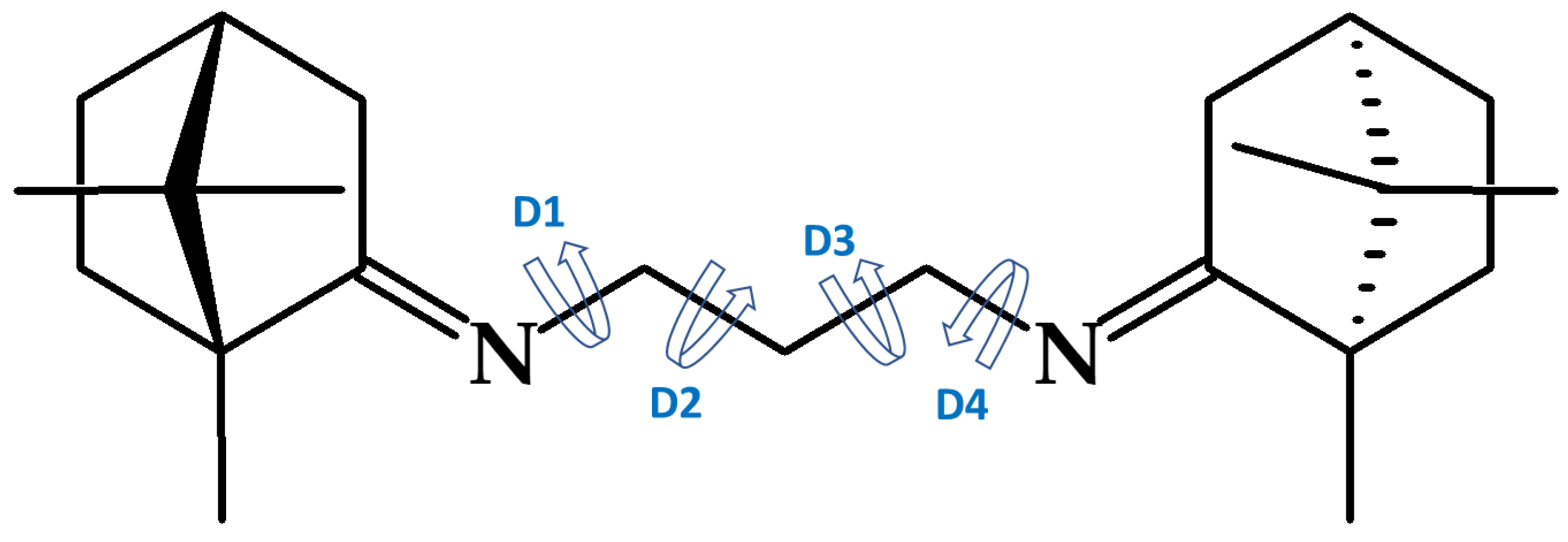
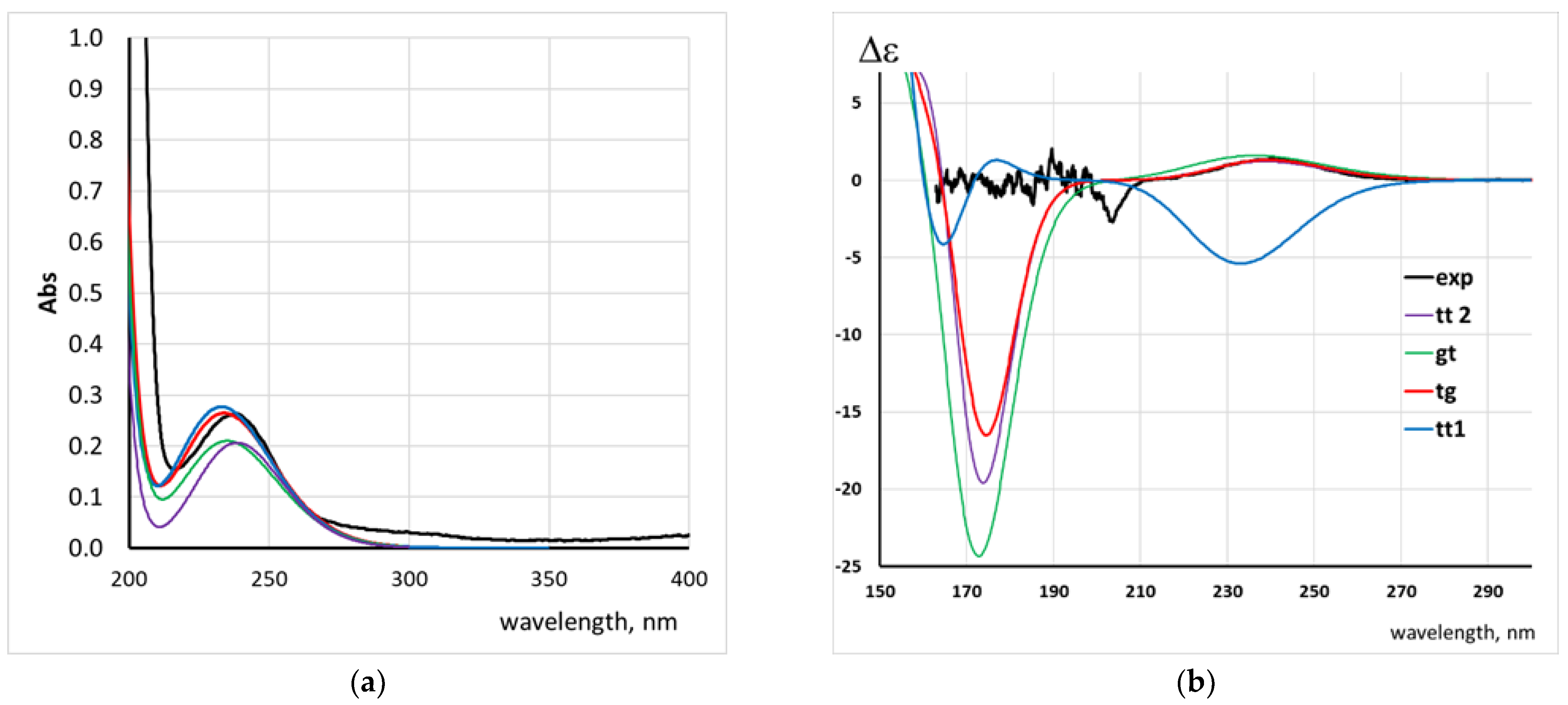

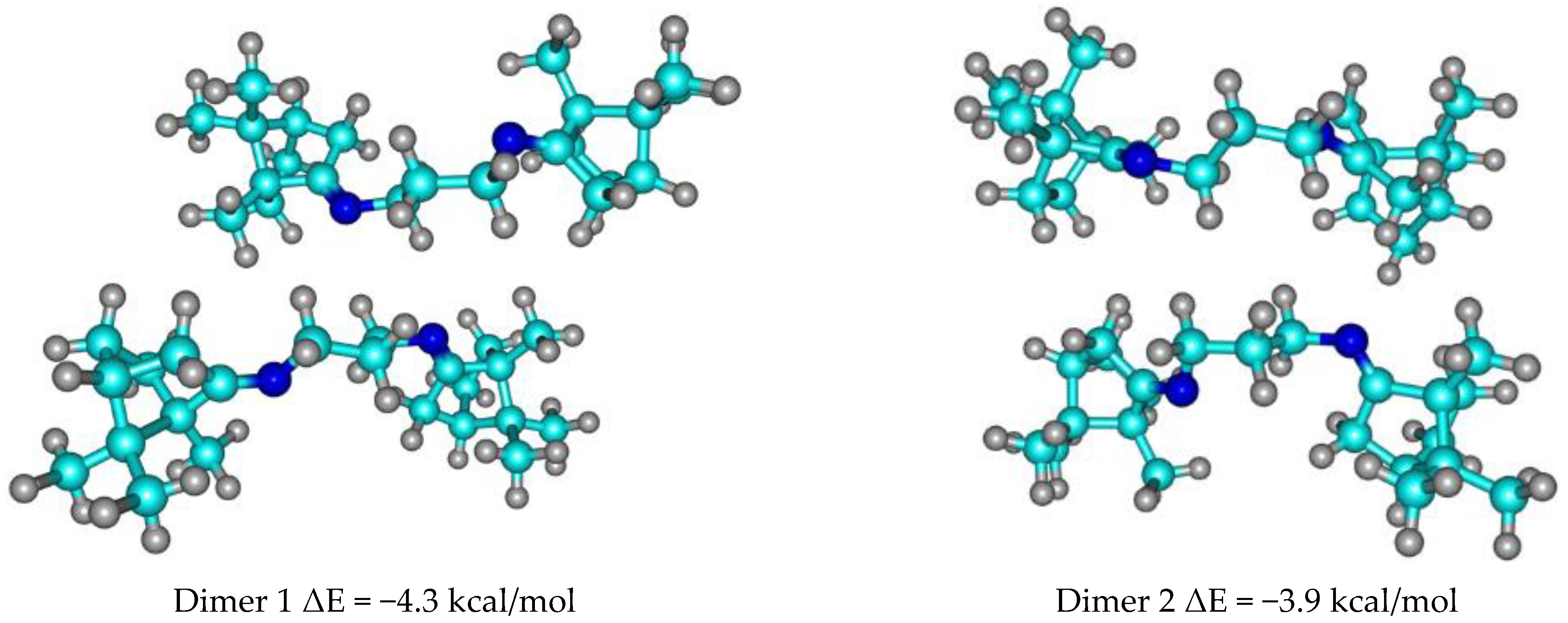

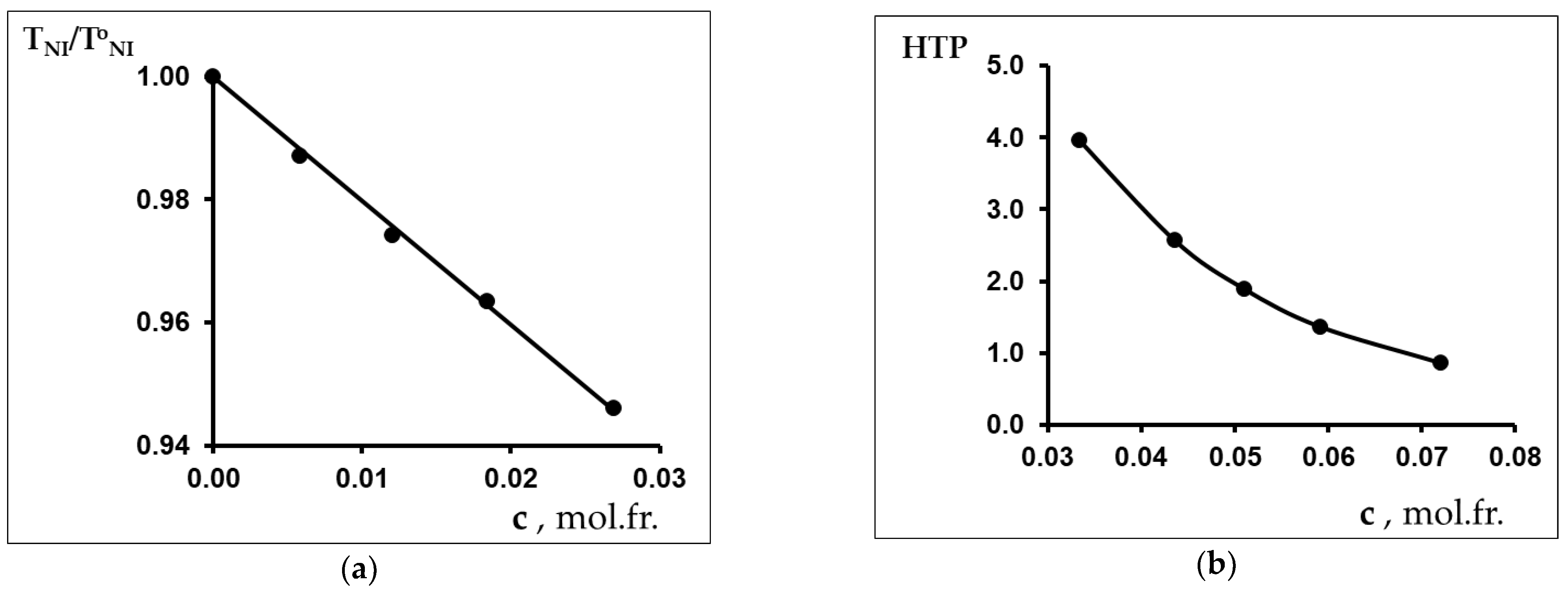
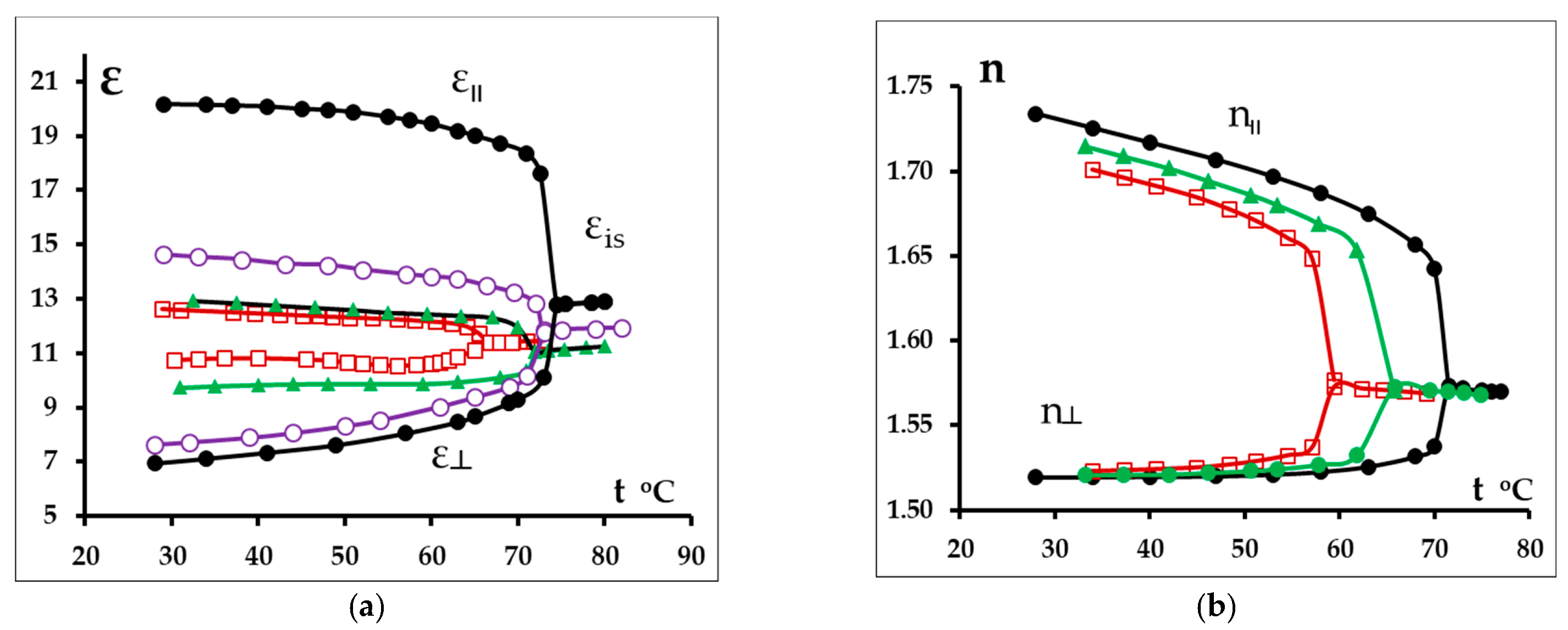
| Conformers | E au | μ, D * | [α] ** | D1 | D2 | D3 | D4 |
|---|---|---|---|---|---|---|---|
| tt-1 | −1008.2841 | 1.76 | −14.1 | 132.0 | 176.0 | 176.0 | 132.2 |
| gt | −1008.2849 | 1.21 | −132.9 | −125.0 | −59.5 | 177.2 | 144.9 |
| tt-2 | −1007.9500 | 1.33 | −172.7 | −119.5 | −174.4 | −174.4 | −119.5 |
| tg | −1008.2850 | 2.29 | −30.7 | 126.5 | 178.6 | 64.2 | 175.8 |
| dimer 1 | −2016.5770 | 0.61 | −47.9 | ||||
| dimer 2 | −2016.5763 | 3.10 | −27.9 |
 | ||||
| Nucleus | Average Deviation, ppm for Conformer | |||
| tt-1 | gt | tt-2 | tg | |
| 1H | 0.087 | 0.139 | 0.177 | 0.057 |
| 13C | 4.90 | 4.16 | 5.08 | 4.11 |
| Chiral Dopant | [α], o (5893.0 A) | β, (mol.fr.)−1 | HTP, (μm)−1 |
|---|---|---|---|
 CDCP | +22.4 * | −1.16 * | 0.57 * |
 HPA | +88.0 ** | −6.24 ** | 2.19 ** |
 CPDA | −29.6 | −2.02 | 3.16 |
Disclaimer/Publisher’s Note: The statements, opinions and data contained in all publications are solely those of the individual author(s) and contributor(s) and not of MDPI and/or the editor(s). MDPI and/or the editor(s) disclaim responsibility for any injury to people or property resulting from any ideas, methods, instructions or products referred to in the content. |
© 2023 by the authors. Licensee MDPI, Basel, Switzerland. This article is an open access article distributed under the terms and conditions of the Creative Commons Attribution (CC BY) license (https://creativecommons.org/licenses/by/4.0/).
Share and Cite
Burmistrov, V.; Batrakova, A.; Aleksandriiskii, V.; Novikov, I.; Belov, K.; Khodov, I.; Koifman, O. Conformational and Supramolecular Aspects in Chirality of Flexible Camphor-Containing Schiff Base as an Inducer of Helical Liquid Crystals. Molecules 2023, 28, 2388. https://doi.org/10.3390/molecules28052388
Burmistrov V, Batrakova A, Aleksandriiskii V, Novikov I, Belov K, Khodov I, Koifman O. Conformational and Supramolecular Aspects in Chirality of Flexible Camphor-Containing Schiff Base as an Inducer of Helical Liquid Crystals. Molecules. 2023; 28(5):2388. https://doi.org/10.3390/molecules28052388
Chicago/Turabian StyleBurmistrov, Vladimir, Alena Batrakova, Viktor Aleksandriiskii, Igor Novikov, Konstantin Belov, Ilya Khodov, and Oskar Koifman. 2023. "Conformational and Supramolecular Aspects in Chirality of Flexible Camphor-Containing Schiff Base as an Inducer of Helical Liquid Crystals" Molecules 28, no. 5: 2388. https://doi.org/10.3390/molecules28052388







